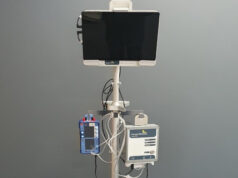
Twelve-month results of the REDUCE LAP HF (Reduce elevated left atrial pressure in patients with heart failure) trial have shown both continued device patency and sustained clinical benefits at one year following implantation of a transcatheter atrial shunt.
The late-breaking clinical trial, presented by principal investigator David Kaye (Alfred Hospital, Melbourne, Australia) at the American Heart Association (AHA) scientific sessions (12–16 November, New Orleans, USA), confirm the continued safety and efficacy of the device following the publication of positive six-month data in The Lancet in March 2016.
Elevated left atrial pressure is a virtual certainty among heart failure with preserved ejection fraction (HFPEF) patients, particularly during exercise. The authors note its incidence as “a near-universal finding” amongst this population, and “a key contributor to morbidity and mortality”. Whilst drug treatment has been shown effective in treatment of other kinds of heart failure, effective medical treatment for HFPEF has proven elusive. Observing the chronicity of the condition, the authors aimed to confirm that positive feasibility earlier results for the novel interatrial septal shunt device (IASD, Corvia Medical) could be sustained in the longer term.
According to a press release from the American Heart Association, the device “facilitates continuous and dynamic decompression of the left atrium by creating a small communication between the upper chambers of the heart.” An earlier computer simulation of the new product predicted that an 8mm shunt device would induce acute left atrial decompression during exercise. Sixty-four patients were implanted with the device, according to inclusion criteria of a left ventricular ejection fraction ≥40%, a New York Heart Association (NYHA) class of II-IV and an elevated pulmonary capillary wedge compression measurement of ≥15mmHg at rest or ≥25mmHg with supine bicycle exercise.
Device safety was assessed according to major adverse cardiac, cerebrovascular and systemic embolic events (MACCE). At six months, zero participants had died or experienced stroke, myocardial infarction, a systemic embolic event, or required implant removal. At one year, three patients (4.7%) had died, one of whom (1.5%) had experienced stroke.
Device performance was measured by echocardiogram or oximetry, with patency confirmed at one year in 54 participants. Left-to-right shunt flow was confirmed by echocardiogram in 100% of patients at six-month (n=49) and one-year (n=48) follow-up. Right-to-left shunt flow was not demonstrated in any patients at either time point. Pulmonary-systemic flow ratio (Qp:Qs) was 1.27%±0.24% at six months, and 1.28%±0.25% at one year.

Clinical efficacy of the devices was shown at six months and persisted to one-year in NYHA class (NYHA; 2.7±0.5 at baseline, 2.1±0.7 at six months, 2±0.6 at one year; n=60, p<0.001), Minnesota Life with Heart Failure (MLWHF; 49.1±20.1 at baseline, 35.1±23 at six months, 34±33 at one year; n=59, p<0.001) score and six-minute walk distance improvements (331m±90m at baseline, 359m±100m at six months, 364m±92m; n=55, p<0.01). This translates to a 15 point average difference from baseline to one year of 15 points in mean MLWHF score, and an average difference of 33m between these time-points in six-minute walk distance.
Echocardiographic results showed statistically significant increases in right ventricle ejection fraction at six months (p<0.05), sustained to one year (p<0.001). Reductions in in left ventricular end-diastolic volume index were recorded at six months (p<0.01), with further reductions observed at one year (p<0.001). Significant increases in right ventricular end-diastolic volume index were observed at six months (p<0.001) and further increases at one year (p<0.001). The authors found no significant change in atrial volumes measured at one year post-implantation.
Invasive haemodynamic results also showed that six-month improvements in cardiac output had been sustained at one-year follow-up in patients with data at all three time-points. Amongst right atrial pressure, mean pulmonary artery pressure, wedge pressure and cardiac output, only the latter showed significant (p<0.01) changes from baseline (5.2mmHg±1.3mmHg) to six months (6.3mmHg±1.8mmHg), which was sustained to one year (6.7mmHg±1.8mmHg).
More significant results were seen in the exercise haemodynamic results. A significant increase (p<0.05) in exercise time was shown at six months, increasing at twelve months, with a significant result (p<0.01 vs. baseline) observed in workload at six months sustained to one year (p<0.01 vs. baseline). Cardiac output had increased significantly by six months (p<0.05), persisting to one year follow-up (p<0.01 vs. baseline).
No significant difference was noted in pulmonary capillary wedge pressure at either time-point. However, when work-indexed, significant decreases in pressure were observed at six months (p<0.05) and sustained through to one year (p<0.01 vs. baseline).
According to the authors, “implantation of an interatrial shunt appears to be safe with an acceptable MACCE rate through one year of follow-up”. With the maintenance of device patency and sustainment of clinical and haemodynamic benefits up to one year, the device shows initial promise. However, highlighting the chronicity of HFPEF, the authors offer caution alongside these results, concluding that “randomised trials are required and ongoing to determine the value of this novel strategy.”












